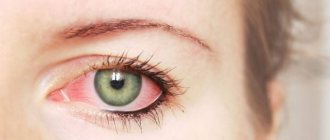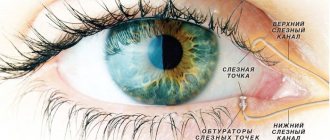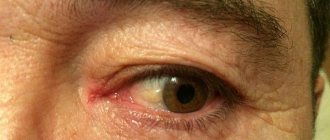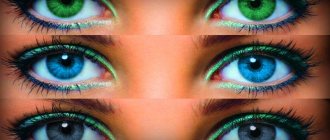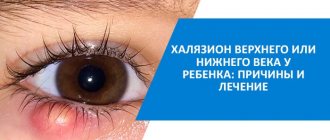During a cold, a person experiences symptoms such as cough, runny nose, fever, watery eyes, general weakness and malaise. Many people know methods of treating such colds. It will not be difficult for anyone to soften a cough, reduce pain in the throat or get rid of a runny nose using well-known pharmaceuticals or traditional medicine.
But tearing of the eyes always remains an open question and often worries patients. Adults mostly attribute this to the consequences of a runny nose or some kind of allergic reaction that will go away on its own. And, in principle, they are right, which cannot be said about the tearing of a child’s eyes, which can be a symptom of a serious illness.
Causes of lacrimation in babies and infants
It often appears along with snot during a runny nose. Parents take these signs as a manifestation of a cold and begin to treat the child for it.
But, if a child (or baby) has watery eyes and snot running, these may not only be signs of a cold. Therefore, it is not worth making an independent diagnosis.
Here's what can cause a runny nose with tears and snot:
- Sinusitis is inflammation of the sinuses, paranasal or paranasal sinuses.
When the nasal septum becomes inflamed, it swells and blocks the passage. The mucus formed in the nose, not finding a way out, puts pressure on the lacrimal canal, causing profuse lacrimation. - These same signs are characteristic of allergic rhinitis.
Until the age of three, allergies in most cases manifest themselves only as symptoms on the skin. And the symptoms we describe are typical for older children. But only a specialist can make a correct diagnosis of an allergic variant after diagnostic procedures.
Watery eyes also appear with a cold. The body rapidly multiplies pathogens with the production of toxins.
Tearing during a cold is observed in the first three to four days, after which it usually goes away or its intensity decreases.
High fever also causes children to cry . This is a common sign of ARVI, and the severity of the disease affects the intensity of lacrimation.
In this case, it is necessary to proceed to treatment immediately, since the child’s temperature can cause serious consequences.
Conjunctivitis also causes excessive tears. Its cause is most often hypothermia, colds, allergies or dirt that gets into the eye through a child’s dirty hands, things or eye injuries.
Most often, only one eye becomes inflamed, but if treated incorrectly or the disease is advanced, there is a risk that the process will spread to the second eye. Then the treatment becomes more complicated.
Obstruction of the tear duct is a very rare cause of excessive tearing. According to statistics, it occurs in only 5% of children.
It is easy to confuse it with conjunctivitis; even experienced doctors make mistakes. Therefore, treatment is prescribed similar to the treatment of conjunctivitis. If it provides temporary relief, then the possibility of tear duct obstruction is considered.
In infants, lacrimation is caused by the teething process. After all, at this time there is a decrease in immunity, viruses infect the entire body.
Why do my eyes hurt when I have the flu?
Flu symptoms are not pleasant at all. Their manifestations are varied. Sometimes it happens that your eyes hurt when you have the flu. This unpleasant phenomenon will be discussed. But first, let's remember the very nature of the flu.
This insidious virus, entering the mucous membrane and not meeting a worthy response from the immune system, begins to multiply with lightning speed, penetrate the cells of the entire body and at the same time release powerful toxins. They poison the body and cause high fever, aches in the joints and muscles, runny nose, headaches, and eye pain.
What causes eye pain?
There may be several reasons why your eyes hurt during colds and flu.
The main cause may be sinusitis. This is one of the unpleasant complications of colds and flu. Sinusitis is an inflammation of the paranasal sinuses, in which the mucous membranes swell, which leads to inflammation of the lacrimal canals, pain in the frontal and periocular area and increased lacrimation.
Sinusitis should be treated under the supervision of a doctor. The doctor will prescribe an adequate examination and treatment, because the paranasal sinuses are not to be trifled with. It's not far from sinusitis here. And then there is no way to do without medical help. If you still decide to self-medicate, then here are some practical tips:
- rinse your nose with a decoction of chamomile, to which you add a little sea salt - this will relieve inflammation;
- thoroughly clean the nasal cavity - in this way you will get rid of mucus, and with it microbes, of which there are countless numbers;
- take some antihistamine - it will remove swelling of the mucous membrane and make breathing easier;
- If you are not a supporter of strong medications, you can try something from homeopathy.
By regularly following these simple tips, you can get rid of sinusitis quite quickly. If the symptoms of the disease do not disappear (or at least do not subside) within 3-5 days, then a visit to the doctor cannot be avoided.
Other causes of eye pain
The cause of painful sensations in the eyeballs during influenza can also be a high temperature. The side effects of this unpleasant phenomenon consist of pain in the eyes and photophobia. These symptoms will disappear as soon as the general condition of the whole body normalizes. To relieve pain, you should follow simple rules:
- close the curtains or darken the window;
- do not strain your eyesight by watching TV, reading or playing on the phone;
- do some simple eye exercises.
Another cause of eye pain with the flu can be such an annoying phenomenon as a migraine. This complication of influenza occurs quite often, especially in people prone to headaches. Here you need to take a painkiller, give your body rest, and as the migraine passes, the pain in your eyes will subside.
Viral conjunctivitis can be one of the unpleasant consequences of the flu. It is very easy for pathogens of all kinds of diseases to penetrate into a weakened body, especially if you suffer from the flu on your feet. Purulent discharge, pain and pain in the eyes are symptoms of conjunctivitis. This disease is treated with rinses and drops. When the course is uncomplicated, it passes quite quickly, within 3-4 days. But if the symptoms do not subside, then immediately consult a doctor!
To avoid getting the flu
As you know, the best treatment for any disease is its prevention.
In order not to be at risk of getting the flu or a cold and not knowing what complications are, you must follow the well-known and simple rules:
- Live a healthy lifestyle. Exercising, walking in the fresh air, proper balanced nutrition, enough sleep - all this will strengthen the body. Then, even if you get a cold or flu, you will survive the illness much easier.
- Preventive vaccinations. Scientists have proven that people who have received a flu vaccine have a several times lower risk of getting sick, and when infected, they tolerate the disease much easier than unvaccinated citizens.
- Exercise reasonable caution. During the peak of the epidemic, it is better to avoid places with large crowds of people. It is healthier to walk a few stops than to lie in bed for a week with a high fever.
- If you do get sick, you shouldn’t suffer the disease on your feet. After all, this attitude towards one’s health leads to various kinds of complications arising, including such as pain in the eyes.
- Try to avoid stress. If this recommendation is difficult to follow, then at least treat yourself to something sweet. As you know, endorphins, the hormones of joy, are the best prevention of all diseases.
As long as humanity has existed, so has the flu. Therefore, in order not to meet him, follow these rules and be healthy!
respiratoria.ru
Treatment
The method of treatment depends on the cause of the watery eyes. You can use medicinal (traditional) treatment or traditional methods.
Traditional treatment:
- For conjunctivitis, it is necessary to wash the eye and instill chloramphenicol drops into the eye - they are approved for use from 4 months of age. You can put tetracycline ointment behind the lower eyelid. These drugs can be used without a doctor's prescription, but it is still better to consult with him.
- If the cause of tears is teething, drugs with an anesthetic effect are used: Kalgel, Dentinox, Metrogyl Denta gels. Don't forget to remove mucus from your nose.
- If an obstruction of the lacrimal duct is diagnosed, the doctor prescribes a massage.
If the procedure is unable to help the baby, then probing is prescribed. The procedure is unpleasant for the baby and is performed quickly. It is performed under local anesthesia. A probe is inserted into the nasolacrimal canal to penetrate the embryonic film. The channel itself is washed with a disinfectant solution. To avoid relapse, a course of massage is prescribed. - For a runny nose, you can instill the following drugs into your child’s nose: Nazivin (it is allowed to be used from 3 months), from 5 months you can use Otrivin, Vibrocil, Xylene.
- If the cause is an allergy, and you know it, then use antihistamines. It is important to stop contact with the allergen.
If a child has a high fever and watery eyes, complex treatment is used . All remedies are prescribed by a doctor; parents only need to follow his recommendations.
Before visiting a doctor, you can help your baby with folk remedies. At least it won't get any worse. We wash the child's eyes with a strong infusion of tea, a decoction of chamomile or calendula.
What is myopia (nearsightedness)? You will find all the details about eye disease in children in these articles:
- What types of myopia are there?
- Causes and treatment in children of preschool and school age.
- Treatment methods and methods of vision correction.
- Manifestations in children under one year of age and older.
Establishing diagnosis
To determine the cause of a runny nose and watery eyes, it is imperative to consult a pediatrician, otolaryngologist or ophthalmologist. The specialist will first analyze the external state of the conjunctiva and mucous membranes, take a nasal and tubular sample.
A test is required that uses collargol (3% concentration). The drug is intended for diagnosing eye conditions. It is instilled onto the conjunctiva, and after 5 minutes it comes out through the nasal passages. If the medicine does not flow down, then there is a violation of the patency of the lacrimal canal in one or both eyes.
Preventive measures
They will help avoid unwanted symptoms or at least reduce their manifestation.
For this:
- Strengthen your child's immunity in every possible way.
- Try to exclude the baby from contact with possible allergens.
- Avoid contact with sick people and do not visit public places during cold epidemics.
- Avoid overheating or hypothermia, especially in cold seasons.
What not to do
First of all, do not self-medicate . The symptoms of many diseases are similar, the risk of error is high. Therefore, before making a diagnosis, it is recommended only to wash the eyes with decoctions.
Take all medications prescribed by your doctor strictly according to the schedule, no independent increase or decrease in dosage!
What to do if a child has watery eyes and a runny nose, what do these symptoms indicate? Let's find out from a specialist:
Most causes are easily eliminated. The main thing is to follow all the doctor’s instructions and not self-medicate.



